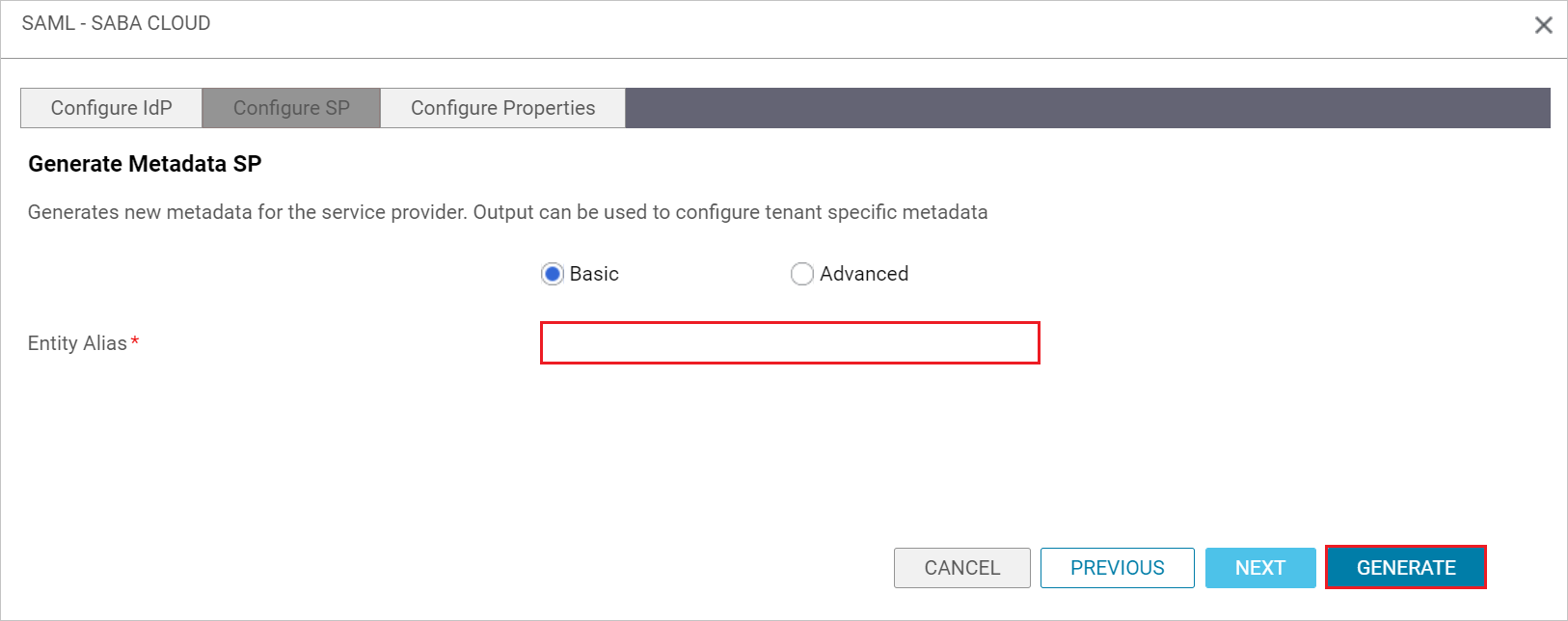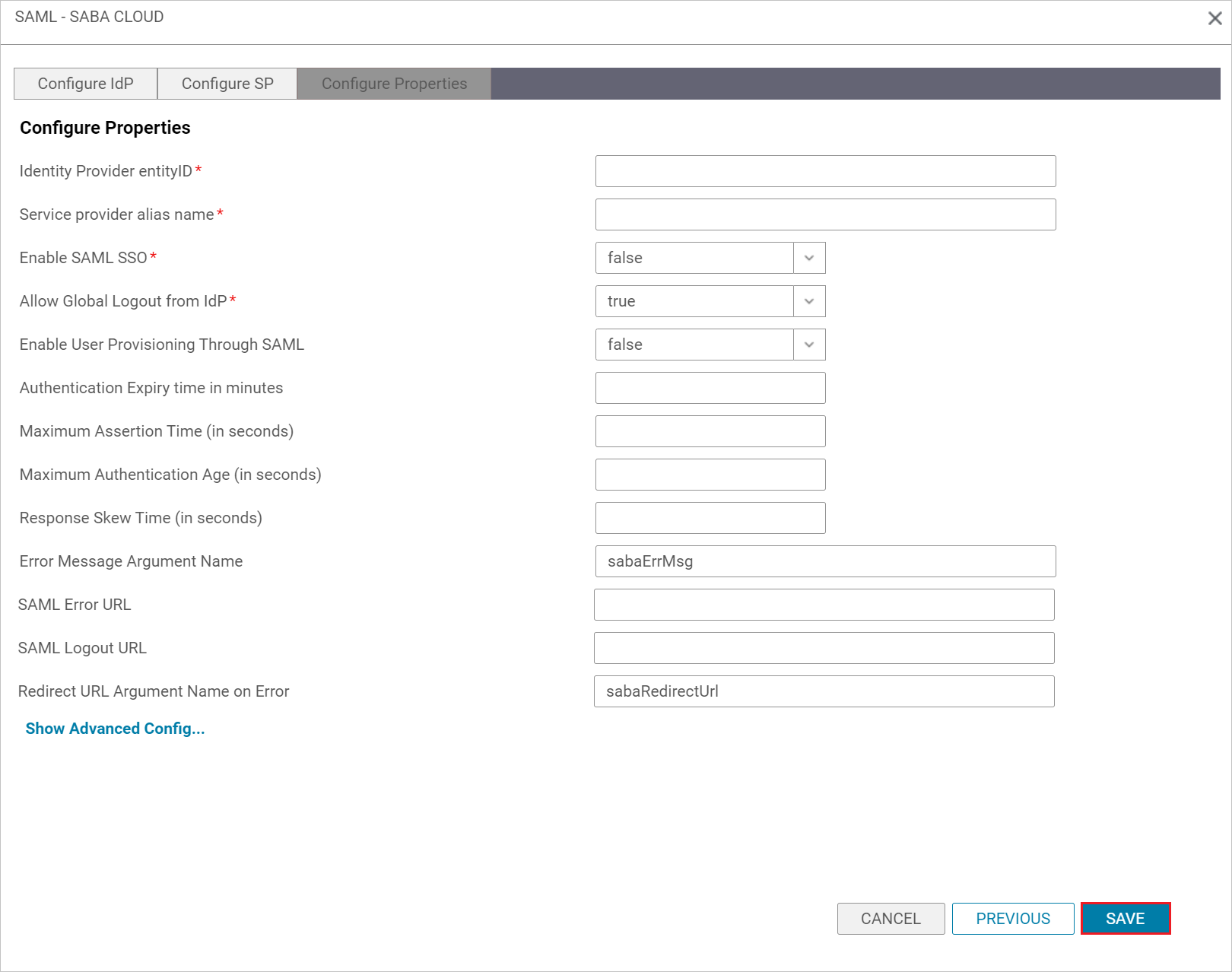Tutorial: Microsoft Entra single sign-on (SSO) integration with Saba Cloud
In this tutorial, you'll learn how to integrate Saba Cloud with Microsoft Entra ID. When you integrate Saba Cloud with Microsoft Entra ID, you can:
- Control in Microsoft Entra ID who has access to Saba Cloud.
- Enable your users to be automatically signed-in to Saba Cloud with their Microsoft Entra accounts.
- Manage your accounts in one central location.
Prerequisites
To get started, you need the following items:
- A Microsoft Entra subscription. If you don't have a subscription, you can get a free account.
- Saba Cloud single sign-on (SSO) enabled subscription.
Scenario description
In this tutorial, you configure and test Microsoft Entra SSO in a test environment.
- Saba Cloud supports SP and IDP initiated SSO.
- Saba Cloud supports Just In Time user provisioning.
- Saba Cloud Mobile application can now be configured with Microsoft Entra ID for enabling SSO. In this tutorial, you configure and test Microsoft Entra SSO in a test environment.
Adding Saba Cloud from the gallery
To configure the integration of Saba Cloud into Microsoft Entra ID, you need to add Saba Cloud from the gallery to your list of managed SaaS apps.
- Sign in to the Microsoft Entra admin center as at least a Cloud Application Administrator.
- Browse to Identity > Applications > Enterprise applications > New application.
- In the Add from the gallery section, type Saba Cloud in the search box.
- Select Saba Cloud from results panel and then add the app. Wait a few seconds while the app is added to your tenant.
Alternatively, you can also use the Enterprise App Configuration Wizard. In this wizard, you can add an application to your tenant, add users/groups to the app, assign roles, as well as walk through the SSO configuration as well. Learn more about Microsoft 365 wizards.
Configure and test Microsoft Entra SSO for Saba Cloud
Configure and test Microsoft Entra SSO with Saba Cloud using a test user called B.Simon. For SSO to work, you need to establish a link relationship between a Microsoft Entra user and the related user in Saba Cloud.
To configure and test Microsoft Entra SSO with Saba Cloud, perform the following steps:
- Configure Microsoft Entra SSO - to enable your users to use this feature.
- Create a Microsoft Entra test user - to test Microsoft Entra single sign-on with B.Simon.
- Assign the Microsoft Entra test user - to enable B.Simon to use Microsoft Entra single sign-on.
- Configure Saba Cloud SSO - to configure the single sign-on settings on application side.
- Create Saba Cloud test user - to have a counterpart of B.Simon in Saba Cloud that is linked to the Microsoft Entra representation of user.
- Test SSO - to verify whether the configuration works.
- Test SSO for Saba Cloud (mobile) to verify whether the configuration works.
Configure Microsoft Entra SSO
Follow these steps to enable Microsoft Entra SSO.
Sign in to the Microsoft Entra admin center as at least a Cloud Application Administrator.
Browse to Identity > Applications > Enterprise applications > Saba Cloud > Single sign-on.
On the Select a single sign-on method page, select SAML.
On the Set up single sign-on with SAML page, click the pencil icon for Basic SAML Configuration to edit the settings.

On the Basic SAML Configuration section, if you wish to configure the application in IDP initiated mode, enter the values for the following fields:
a. In the Identifier text box, type a URL using the following pattern (you'll get this value in the Configure Saba Cloud SSO section on step 6, but it usually is in the format of
<CUSTOMER_NAME>_sp):<CUSTOMER_NAME>_spb. In the Reply URL text box, type a URL using the following pattern (ENTITY_ID refers to the previous step, usually
<CUSTOMER_NAME>_sp):https://<CUSTOMER_NAME>.sabacloud.com/Saba/saml/SSO/alias/<ENTITY_ID>Note
If you specify the reply URL incorrectly, you might have to adjust it in the App Registration section of Microsoft Entra ID, not in the Enterprise Application section. Making changes to the Basic SAML Configuration section doesn't always update the Reply URL.
Click Set additional URLs and perform the following step if you wish to configure the application in SP initiated mode:
a. In the Sign-on URL text box, type a URL using the following pattern:
https://<CUSTOMER_NAME>.sabacloud.comb. In the Relay State text box, type a URL using the following pattern:
IDP_INIT---SAML_SSO_SITE=<SITE_ID>or in case SAML is configured for a microsite, type a URL using the following pattern:IDP_INIT---SAML_SSO_SITE=<SITE_ID>---SAML_SSO_MICRO_SITE=<MicroSiteId>Note
These values are not real. Update these values with the actual Identifier, Reply URL, Sign-on URL and Relay State. Contact Saba Cloud Client support team to get these values. You can also refer to the patterns shown in the Basic SAML Configuration section.
For more information about configuring the RelayState, see IdP and SP initiated SSO for a microsite.
In the User Attributes & Claims section, adjust the Unique User Identifier to whatever you organization intends to use as the primary username for Saba users.
This step is required only if you're attempting to convert from username/password to SSO. If this is a new Saba Cloud deployment that doesn't have existing users, you can skip this step.
On the Set up single sign-on with SAML page, in the SAML Signing Certificate section, find Federation Metadata XML and select Download to download the certificate and save it on your computer.

On the Set up Saba Cloud section, copy the appropriate URL(s) based on your requirement.

Create a Microsoft Entra test user
In this section, you'll create a test user called B.Simon.
- Sign in to the Microsoft Entra admin center as at least a User Administrator.
- Browse to Identity > Users > All users.
- Select New user > Create new user, at the top of the screen.
- In the User properties, follow these steps:
- In the Display name field, enter
B.Simon. - In the User principal name field, enter the username@companydomain.extension. For example,
B.Simon@contoso.com. - Select the Show password check box, and then write down the value that's displayed in the Password box.
- Select Review + create.
- In the Display name field, enter
- Select Create.
Assign the Microsoft Entra test user
In this section, you'll enable B.Simon to use single sign-on by granting access to Saba Cloud.
- Sign in to the Microsoft Entra admin center as at least a Cloud Application Administrator.
- Browse to Identity > Applications > Enterprise applications > Saba Cloud.
- In the app's overview page, select Users and groups.
- Select Add user/group, then select Users and groups in the Add Assignment dialog.
- In the Users and groups dialog, select B.Simon from the Users list, then click the Select button at the bottom of the screen.
- If you are expecting a role to be assigned to the users, you can select it from the Select a role dropdown. If no role has been set up for this app, you see "Default Access" role selected.
- In the Add Assignment dialog, click the Assign button.
Configure Saba Cloud SSO
In a different web browser window, sign in to your Saba Cloud company site as an administrator
Click on Menu icon and click Admin, then select System Admin tab.

In Configure System, select SAML SSO Setup and click on SETUP SAML SSO button.

In the pop up window, select Microsite from the dropdown and click ADD AND CONFIGURE.

In the Configure IDP section, click on BROWSE to upload the Federation Metadata XML file, which you have downloaded. Enable the Site Specific IDP checkbox and click IMPORT.

In the Configure SP section, copy the Entity Alias value and paste this value into the Identifier (Entity ID) text box in the Basic SAML Configuration section. Click GENERATE.

In the Configure Properties section, verify the populated fields and click SAVE.

You might need to set Max Authentication Age (in seconds) to 7776000 (90 days) to match the default max rolling age Microsoft Entra ID allows for a login. Failure to do so could result in the error
(109) Login failed. Please contact system administrator.
Create Saba Cloud test user
In this section, a user called Britta Simon is created in Saba Cloud. Saba Cloud supports just-in-time user provisioning, which is enabled by default. There is no action item for you in this section. If a user doesn't already exist in Saba Cloud, a new one is created after authentication.
Note
For enabling SAML just in time user provisioning with Saba cloud, please refer to this documentation.
Test SSO
In this section, you test your Microsoft Entra single sign-on configuration with following options.
SP initiated:
Click on Test this application, this will redirect to Saba Cloud Sign on URL where you can initiate the login flow.
Go to Saba Cloud Sign-on URL directly and initiate the login flow from there.
IDP initiated:
- Click on Test this application, and you should be automatically signed in to the Saba Cloud for which you set up the SSO
You can also use Microsoft My Apps to test the application in any mode. When you click the Saba Cloud tile in the My Apps, if configured in SP mode you would be redirected to the application sign on page for initiating the login flow and if configured in IDP mode, you should be automatically signed in to the Saba Cloud for which you set up the SSO. For more information about the My Apps, see Introduction to the My Apps.
Note
If the sign-on URL is not populated in Microsoft Entra ID then the application is treated as IDP initiated mode and if the sign-on URL is populated then Microsoft Entra ID will always redirect the user to the Saba Cloud application for service provider initiated flow.
Test SSO for Saba Cloud (mobile)
Open Saba Cloud Mobile application, give the Site Name in the textbox and click Enter.

Enter your email address and click Next.

Finally after successful sign in, the application page will be displayed.

Next steps
Once you configure Saba Cloud you can enforce session control, which protects exfiltration and infiltration of your organization’s sensitive data in real time. Session control extends from Conditional Access. Learn how to enforce session control with Microsoft Defender for Cloud Apps.
Feedback
Coming soon: Throughout 2024 we will be phasing out GitHub Issues as the feedback mechanism for content and replacing it with a new feedback system. For more information see: https://aka.ms/ContentUserFeedback.
Submit and view feedback for